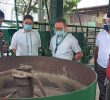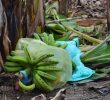Davao City-Despite the decreasing number of foreign fishing vessels unloading their catch in the city, the Davao fishport complex located in Toril, Davao City and the only transshipment port in the country, remains financially and operationally viable.
During a recent Davao business forum, port manager Mario Malinao bared that, inspite of the skyrocketing cost of fuel that has worsened in 2006 up to the present, the Davao fishport complex had gross proceeds of 36.349 million pesos and net proceeds of 8.21 million pesos last year.
“What we did is tighten our belt to save on operating cost. That is why our expenditure is lower compared the previous years,” he said. He said that, fishport operating cost ratio for previous years was between 80 to 85 centavos. For this year, they only spent 78 centavos for every peso earned, which meant net proceeds of 22 percent.
For 2005, Malinao reported that gross proceeds was at 31.5 million pesos and the net income at 7.3 million pesos. For 2006, gross proceeds was at 36.02 million pesos while net income was at 10.7 million pesos, the highest recorded revenue. Malinao said that for 2008 they are still within their projection level of their target of 39 million pesos.
Malinao, however, bared a decline in the number of arrivals of foreign vessels from January to July this year with only 289 compared to the 429 in the same period last year.
He explained that the decrease in volume cannot be attributed to some Taiwanese commercial fishermen who accommodate the catch of their fellow businessmen to also save on operational expenses. “Fishing is badly affected by the high cost of oil and other commodities,” he said.
He said one foreign commercial fishing vessel would need 500,000 pesos operating cost for a 20-day operation. He said while the airline cost for cargoes is a factor for the decline, the fuel per drum is another factor. The Davao price per 200-liter drum of fuel is 8,000 pesos. In Bitung, Indonesia, it would only cost fishermen 3,500 pesos.
Malinao said that upgrading fishport facilities, however, could be a big boost.
Malinao explained that there were eight fishports in the country. In Mindanao, the other two are in General Santos City and Zamboanga City; in Visayas there is one fishport in Iloilo City and there are four in Luzon. The 4.5-hectare Davao fishport is the second smallest port among the eight but is the only transshipment port in the Philippines and Malinao said the Davao fishport has lot of potential and good facilities would attract more fishing vessels.
Other transshipment ports are located in Guam, Palau and Bitung. However, the Davao port has an advantage over the ones in Palau and Bitung because of the regular flight from Davao which carries the tuna for auction to California, USA, Vancouver, Canada, Tokyo, Fukuda and Osaka in Japan.
The tuna has to be shipped fresh (chilled) and must reach its destination within 24 hours, he said.
He said the Port Authority of Guam had been servicing long line vessels since 1986 compared to Davao, which only started operating in 1995. “But we can say that our port is at par with that of Guam,” he said.
Inside the Davao fishport are 24 business locators, 12 transshipment operators that are registered with the Philippine Securities and Exchange Commission, eight fish processors, four small to medium fish traders/buyers, three allied services that includes the biggest cold storage operated by the Polar Bear, 15 residue buyers, five small fish buyers and 38 other fish traders.
Malinao also said that, at any given time, the fishport can accommodate 40 vessels in its berthing space
He said there are 5,000 foreign fishing vessels operating in the international waters in the Pacific and Davao fishport only gets 300 to 320 of them. These vessels, he added, are being managed and facilitated by the Western Central Pacific Fisheries Commission (WCPFC) based in Guam composed of at least 40 countries, with the Philippines as a member.
However, Malinao admitted that another source of the slowdown for this year was the poor catch. He said many vessels can only get about three tons of catch. In the economies of scale, he said, this is not viable because a small vessel could only accommodate 10 tons while the big ones can accommodate 30 tons.
He attributed the decline in the production with the drastic climate change and weather condition that made fish stock in the ‘tuna highway’ decline, aside from the spiralling cost of diesel fuel.
He said that during the past years these foreign fishing vessels unload about 10 tons of catch at the Davao fishport but this year it is already a good catch if they get 5 tons.
The Taiwanese, he added, after unloading their catch, would leave immediately. Before, they would stay for five days.
Malinao also said that the volume of catch unloaded by the foreign long line vessels at the Davao port has decreased by 16 percent. From January to July this year, foreign vessels only unloaded 2,380 metric tons, while they unloaded 2,755 metric tons in the same period last year. (PIA)










